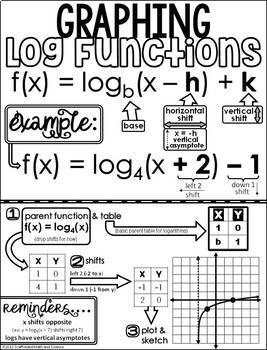Scaffolded Math and Science
30.4k Followers
Resource Type
Standards
CCSSHSA-REI.D.11
CCSSHSF-IF.C.7
Formats Included
- PDF
Pages
1 page
Scaffolded Math and Science
30.4k Followers
Also included in
- This algebra 2 activities bundle includes all of the current printable and digital algebra 2 activities in my store, along with all future additions. All updates to the bundle are free.Topics covered:Exponentials, inverses, complex numbers, domain and range, increasing and decreasing, logarithms, rPrice $60.00Original Price $155.00Save $95.00
Description
This reference sheet for graphing logarithmic functions walks students through identifying x and y shifts and the base, identifying the parent function, creating a table for the parent function, shifting the parent table, plotting the points from the shifted table and sketching in the vertical asymptote.
Students can color the reference sheet to personalize it for their notebook or binders. The sheet can also be enlarged into a poster as an anchor chart for graphing logs. *Includes video link.
You may also like:
Solving Logarithm Equations Digital Math Escape Room
Graphing Exponential Functions Cheat Sheet
Total Pages
1 page
Answer Key
N/A
Teaching Duration
N/A
Report this resource to TPT
Reported resources will be reviewed by our team. Report this resource to let us know if this resource violates TPT’s content guidelines.
Standards
to see state-specific standards (only available in the US).
CCSSHSA-REI.D.11
Explain why the 𝘹-coordinates of the points where the graphs of the equations 𝘺 = 𝘧(𝘹) and 𝘺 = 𝑔(𝘹) intersect are the solutions of the equation 𝘧(𝘹) = 𝑔(𝘹); find the solutions approximately, e.g., using technology to graph the functions, make tables of values, or find successive approximations. Include cases where 𝘧(𝘹) and/or 𝑔(𝘹) are linear, polynomial, rational, absolute value, exponential, and logarithmic functions.
CCSSHSF-IF.C.7
Graph functions expressed symbolically and show key features of the graph, by hand in simple cases and using technology for more complicated cases.





